Immune Regulator PWWP3A Helps Viruses Evade Body Defense and Worsens RNA Infections
Nikhil Prasad Fact checked by:Thailand Medical News Team May 02, 2025 7 months, 1 week, 3 days, 11 hours, 47 minutes ago
Medical News: Scientists Discover How a Hidden Protein Weakens the Body’s First Line of Defense Against RNA Viruses
A groundbreaking discovery by Chinese scientists has uncovered a little-known protein called PWWP3A that helps RNA viruses like SARS-CoV-2 and influenza escape the body’s early immune response. This finding could help reshape how future treatments and vaccines are developed for viral diseases.
 Immune Regulator PWWP3A Helps Viruses Evade Body Defense and Worsens RNA Infections
Immune Regulator PWWP3A Helps Viruses Evade Body Defense and Worsens RNA Infections
Researchers from the State Key Laboratory of Virology and Biosafety and Frontier Science Center for Immunology and Metabolism at Wuhan University, together with scientists from Westlake University, Lanzhou University, and SpecAlly Life Technology Co. Ltd., have revealed how the protein PWWP3A acts as a hidden saboteur inside the immune system. This
Medical News report explores how this protein interferes with our ability to fight off RNA viruses during the earliest stages of infection.
The Role of VISA and the Interference Caused by PWWP3A
Our innate immune system is designed to detect and respond quickly to viral invaders. One of the most critical components of this system is the mitochondrial antiviral signaling protein, also known as VISA or MAVS. When a virus enters the body, VISA sets off a chain reaction that activates proteins like TBK1 and IRF3. These proteins eventually produce type I interferons—natural virus fighters that block the infection.
However, the study reveals that PWWP3A can sneak out of the cell’s nucleus and attach itself to VISA at the mitochondria. Once there, it blocks the connection between VISA and another key player, TRAF6. This blockage prevents TBK1 from being activated and disrupts the whole defensive chain reaction. As a result, the body’s frontline immune response is weakened, giving viruses more time to multiply.
Viruses Trigger the Breakdown of PWWP3A But Not Fast Enough
Interestingly, the body does have a way to deal with PWWP3A—but it’s often too little, too late. The study found that after viral infection, an enzyme called PJA2 marks PWWP3A for destruction using a process known as polyubiquitination. Unfortunately, the breakdown of PWWP3A is not immediate. This delay gives viruses a window of opportunity to escape immune detection and spread.
In laboratory tests, human cells and genetically engineered mice lacking PWWP3A responded much better to infections from RNA viruses like Sendai virus, vesicular stomatitis virus (VSV), and even a modified version of SARS-CoV-2. These PWWP3A-deficient models produced higher levels of protective interferons and were able to resist severe infections far more effectively than normal subjects.
No Impact on DNA Viruses and Implications for Future Research
The researchers confirmed that PWWP3A specifically affects the body’s response to RNA viruses and not DNA viruses such as herpes simplex virus (HSV-1). This finding helps p
inpoint PWWP3A’s unique role and suggests that any therapies targeting it would not interfere with the immune response to other types of pathogens.
Furthermore, mice that lacked the PWWP3A gene showed increased survival rates and lower viral loads in their organs when exposed to lethal doses of influenza and VSV. Their immune systems were faster and stronger, with higher levels of protective cytokines like interferon-beta, IL-6, and MCP-1 being produced during infection.
Conclusion
The discovery of PWWP3A’s inhibitory role in antiviral immunity provides a significant leap in understanding how some viruses gain an early advantage inside the body. By blocking the recruitment of TBK1 to VISA and interfering with TRAF6 binding, PWWP3A helps viruses escape immune detection during the critical early stages of infection. This makes it a promising target for new antiviral drugs that could enhance innate immune responses. While further studies are needed, eliminating or controlling PWWP3A could lead to breakthroughs in preventing severe infections and improving vaccine efficiency, particularly for RNA viruses that continue to pose global health threats.
The study findings were published in the peer reviewed journal: Nature Communications.
https://link.springer.com/article/10.1038/s41467-025-59421-x
For the latest in Immunology, keep on logging to Thailand
Medical News.
Read Also:
https://www.thailandmedical.news/news/newly-discovered-mysterious-human-gene-vilmir-found-to-be-activated-by-flu-covid-19-and-rsv-infections
https://www.thailandmedical.news/news/new-insights-into-how-natural-killer-cells-fight-viral-infections
https://www.thailandmedical.news/news/monocyte-production-of-c1q-enhances-cd8-t-cell-function-against-respiratory-viruses
https://www.thailandmedical.news/articles/immunology
https://www.thailandmedical.news/pages/thailand_doctors_listings
Follow us on:
https://x.com/ThailandMedicaX
https://www.facebook.com/ThailandMedicalNews
https://bsky.app/profile/thailandmedical.bsky.social
https://gettr.com/user/thailandmedicalnews
https://www.tribel.com/thailandmedical/wall
and 33 other social media platforms
